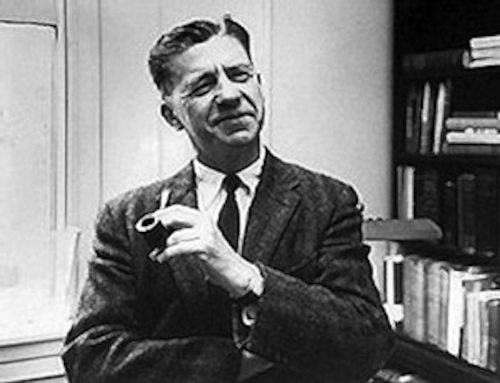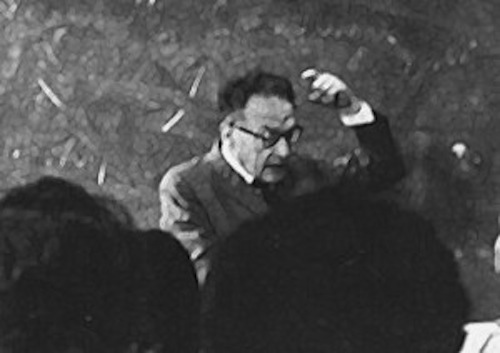Towards a Poetics of the Phatic (Part 1)

[The following is derived from my notes for a talk I gave at the "Rethinking Poetics" conference held at Columbia University on Friday, June 11, 2010.]
M. H. Abrams’s 1953 introduction to The Mirror and the Lamp (“The Orientation of Critical Theories”) isolates four coordinates that he says inform almost all comprehensive theories of art: the work, the artist, the universe, and the audience. He arranges these into “a convenient pattern”:

Abrams says that “a critic tends to derive from one of these terms his principal categories for defining, classifying, and analyzing a work of art, as well as the major critieria by which he judges its value.” Accordingly, he outlines what he considers to be the four most influential orientations of poetic theory, each of them with one of these coordinates as its central focus.
1) The mimetic orientation (Plato, Aristotle, Sidney, Marxism): poetry as imitation of reality—“a speaking mirror.” The mimetic mode might be thought of as the dominant principle underwriting not just literature but language itself: the attempt to reflect the real justly through symbolic representation, to substitute word for world in such a way that verisimilitudinous correspondence persists between the two. In this sense, it has parallels with what Roman Jakobson (in “Linguistics and Poetics,” 1960) terms the referential function of language, or “set toward the context,” its capacity to communicate relevant information.
2) The pragmatic tradition (Horace, Sidney, Johnson, Marxism): poetry as a means toward an end—“to teach and delight.” Instruction and pleasure are both factors having to do primarily with reception. The pragmatic mode corresponds to Jakobson’s conative function, or “set toward the addressee,” in which the aim of a given utterance is to produce certain responses or effects in the audience.
3) The expressive orientation (Longinus, Wordsworth, Mill, psychoanalytic criticism): poetry as index of author’s subjectivity—“spontaneous overflow of powerful feeling.” There is clear relevance here to Jakobson’s emotive function, or “set toward the addresser.”
4) The objective orientation (Aristotle, Moritz, Kant, Russian Formalism, New Criticism, etc.): poetry as self-determined structure—“no ideas but in things,” as W. C. Williams put it. A focus on the linguistic object as such is the chief feature of Jakobson’s poetic function, or “set toward the message.” It is not surprising that a theorist operating firmly within one of the critical movements most directly associated with an objective approach (i.e., structuralism) would assign the privileged label of “poetic” to that linguistic mode which most directly reflects his own affiliation.
Jakobson also identifies a metalingual function, or “set toward the code,” in which the purpose of the utterance is merely to define other utterances. It is easy enough to relate this to the many long-standing traditions of definitional criticism, archival studies, literary biography, etc.—and in fact, Abrams’ own discussion falls squarely within this category, as it is precisely an attempt to taxonomize and clarify the existing concepts informing critical theory.

The remaining of Jakobson’s six linguistic functions is the phatic, the “set towards the contact.” Phatic utterances serve the purpose of determining that the addresser and the addressee have an open channel of transmission and reception. Though phatic utterance may include the use of terms and phrases which have referential content, this content is not its salient factor. Jakobson evinces the speech of talking birds as an example of pure phasis, or language use motivated above all else by the fact of its own performance and continuance.
Although poetry has been exploring the resources of the phatic now for decades, there has been relatively little coherent and expansive development of a critical tradition informed by its principles. Most criticism of contemporary poetry (even experimental poetry) still works squarely within the parameters of the mimetic, pragmatic, objective, and even expressive orientations identified by Abrams (or at the metalingual and paracritical level of bibliographical and definitional scholarship). At times the anachronism of this situation is palpable, especially when styles of close reading lifted whole from New Critical practice are applied to texts that clearly resist the logic of organic unity and formalist autonomy inherent in such approaches. Similarly, much criticism tends to assume a mimetic aesthetic in work that wields such effects, if at all, in ironic or otherwise negational modes, or to assume emotive priority in cases where such priority is demonstrably qualified by phatic maneuvers. The pragmatic critical tradition perhaps retains a higher degree of applicability to contemporary poetic practice, as it is arguable that one goal of the phatic is the establishment of a strong bond with given readerly communities who recognize its codes, but here as well there persists an investment in naïve and outdated models of poetry’s “relevance” to social and political themes.
What would a phatic-oriented critical tradition look like? What texts would be most amenable to being viewed through the lens of the phatic, and how, in turn, would theory synthesize the sum of these viewings into a coherent poetics? What would be its incentive, its purpose, its relevance? In my next post, I’ll examine these questions further.
K. Silem Mohammad is the author of several books of poetry, including Deer Head Nation (2003), A Thousand…
Read Full Biography

